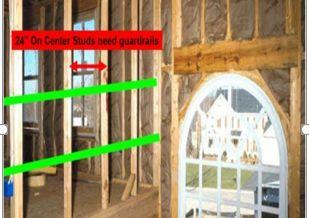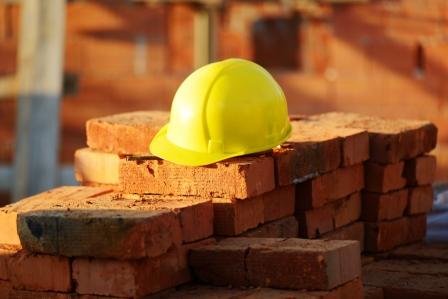Whether you work at height every day or only on occasion, working safely should always remain a top priority. It takes one mistake to turn a routine task into a serious injury or fatality. You must be prepared to protect your employees each and every time they could be exposed to a fall hazard.
What is Working at Height?
Working at height refers to any work where a person could potentially fall and injure themselves. A ladder, a roof’s edge, an opening on the floor, and even a loading dock can be considered working at height. In the general industry, fall protection is required by OSHA for any height change of 4 feet or more.
1. Use Railing.
When you can, use the railing. The railing is a form of Passive protection, the easiest and most recommended way to keep your workers safe while achieving compliance. There’s no training or extra equipment needed because there’s nothing that they need to actually do to keep themselves safe (other than stay within the rail). There is a railing system for almost every style of rooftop such as non-penetrating roof railing, parapet-mounted railing, metal roof railing, Regardless of which type you use, once in place, you’ll find rails to be the easiest fall protection system to use.
2. Select the Proper PPE.
If you’re going to use Personal Fall Arrest Systems (PFAS), you need to ensure you’re choosing the proper equipment. All full-body harnesses that meet ANSI standards will perform the same, despite their cost. However, that price differential can get you something extra. Sure, sometimes it’s just a name, but other times its functionality that you’re gaining or sacrificing, such as extra D-rings, fireproof material, or arc-safe design. Sometimes, a more expensive harness costs more simply because it’s been made to be more comfortable.
Do your research and determine what you really need. If you have workers welding at heights, then a standard nylon harness probably won’t have the heat protection you need; Kevlar might be the best option. Comfort is important, but the main concern has to be the ability to adjust the harness so it fits the user properly, ensuring it works as designed.
Safety lanyards need to be properly selected as well. Depending on the height at which you are working, a 6’ lanyard with a deceleration device may not protect your worker. Instead, a retractable lanyard might be necessary. Each situation is different,
3. Inspect Your PPE.
Great. You’ve got the equipment you need to ensure a protected work environment. That won’t matter if the systems are worn to the point that they fail. Harnesses and lanyards need to be inspected annually, if not more frequently, by a competent person (one with the knowledge to recognize the hazard AND the authority to correct it). However, PPE should be inspected by the user prior to every use. It’s important that anyone who might be using the devices understands what they’re looking for, what is acceptable or not, and the steps to take should there be an issue. A pre-use check doesn’t have to take a lot of time but needs to be thorough. This step could be the difference between life and death.
4. Ensure You Understand Fall Distance.
You can wear all the fall protection equipment in the world, but if it fails to engage before you hit something, it’s pointless. This may sound like a “common sense” statement, but you’d be surprised at how easy it is to get this part wrong. It is not unusual to go onto a construction site or observe a maintenance crew in a plant and see a worker at 10-12’ (around 3.0-3.6 m) off the ground wearing a 6’ (1.8 m) lanyard with a deceleration device. While at first glance you might think that it should work, there are a number of reasons why it won’t.
First, you have to add 3.5’ (around 1.00 m) of distance to account for the deployment of your deceleration device. Already that means the lanyard is equal to a 9.5’ (2.8 m) drop. Unless you are a 6” (1.8 m) tall person, this is some pretty bad news. Your actual fall distance needs to not only include the length of your lanyard when deployed but also your body length below the D-ring AND any sag in your harness and anchor system. Count on a good 18.5’ (5.6 m) minimum before you’re able to use a 6’ (1.8 m) lanyard with a deceleration device. Correctly calculate the minimum distance for fall clearance before you need to use the system.
5. Select an Acceptable Anchor Point.
By this point, you might be realizing that there are a lot of factors involved when it comes to fall safety, especially PPE. Well, we’re just getting into it. What good is the right harness and lanyard set up if the anchor point won’t hold the load? The answer is none.
What constitutes an acceptable anchor point? It’s not a PVC pipe. Nor is it a decorative piece of steel on the roof. An anchor point is only acceptable if:
- it’s designed and approved by a professional engineer that has calculated the expected loads or
- it can clearly handle a load of 5,000 pounds (around 2200kg).
Since many structures will not withstand these forces, choose structural steel with a proper beam clamp. Or, if installed correctly, a manufactured roofing cart or anchor.
6. Use the Proper Equipment for Working at Heights (Scaffold vs Lift vs Ladder).
Just as harnesses are not one-size-fits-all, neither are fall protection solutions. In some situations, a scaffold is going to be your best solution to work at heights. This might be for painting a house or washing low-level windows. If so, equip the scaffolding with a railing. This safety precaution will make your fall protection much easier to address. Other times, scaffolds will be infeasible and you’ll find yourself on a lift. Depending on the type of lift, you may or may not need to wear a harness and lanyard (such as when using a scissor lift). Still other times, you’ll be using a ladder, at which point the requirements for fall protection become trickier. We’ll talk about that further down. Portable, durable scaffolding can replace work from a ladder.
In the end, it’s important to recognize your situation and what type of elevation system is required, whether that be a ladder, scaffold, aerial lift, stairwell protection system, or any other solution.
7. Ensure Proper Use of Aerial Lifts.
There are many ways in which something can go wrong when operating an aerial lift, so I won’t get into the actual operation here. However, we do need to discuss lifts with fall protection. One thing that gets missed quite often is that any person in a boom lift, at any time or height, must be properly tied off.
“Properly tied-off” not only means that they need to be secured to the engineered anchor point designed for the lift, but it means that they can’t wrap their lanyard around the rails and they need to have a lanyard that is actually going to protect them at the height at which they are working (see fall distance above). With scissor lifts, things are a little different. While the site you are working on or the owner of the facility/project may require you to tie-off off a scissor lift, there is no regulatory requirement to do so. However, even the smallest mistake can endanger your life. It could simply be forgetting to close your gate or secure your chain. One basic step you can take to decrease the risk of a fall is keeping both feet planted firmly on the work platform.
8. Use Ladders Properly
Ladders lie at the source of many industrial and workplace accidents simply because we take their use for granted. Before using a ladder, consider whether or not they are the best solution for the task. Then make sure your employees are trained to properly use a ladder. It’s not as simple as you might think. For safe ladder handling, there are three main concepts to consider.
- Have a 3 ft (1 m) extension of the ladder past the level to which you are climbing.
- Have a 4:1 ratio of rising and running.
- Basically, for every four feet high the ladder rises, place the base of the ladder one foot away from the structure.
- Ensure you have three points of contact with the ladder at all times.
Two legs, one hand. Two hands, one leg. If you think about it, this means you do not carry something such as a bucket up or down a ladder. This would force you to break the three-point rule. Find another means like pulling it up by a rope after transitioning or holding smaller items in a belt or pocket.
Do these things and you’ll have a great start to a secure extension ladder experience.
Even for a basic step ladder, it is important to provide your employees with proper training. Covering even the most simple steps can decrease the risk of hazards at your workplace.
For fixed ladders over 24’ high (7 m), you will want to ensure that your workers are using a ladder safety system, which includes a lanyard, harness, and a continuous vertical lifeline (cable or rigid rail) that spans the height of the ladders. Cages are no longer a proper means of fall protection. And that’s just the climb. Don’t forget the transition at the top. Make sure that it is protected by a ladder safety gate and premier fall protection for a secure, safe experience.
9. Know When and What type of Fall Protection is Required.
There are three factors to think about when considering when and what type of fall protection is required by OSHA: frequency, duration, and location of work. OSHA now uses two terms that will help you determine the frequency and duration of work taking place.
- Infrequent: Work that is performed once a month or less
- Temporary: Simple, short-term tasks that take 2 hours or less to complete
- Location of Work: Once you’ve determined the frequency and duration, you will need to determine the location of the work in proximity to the hazard.
10. Train, Train, Train.
It’s been mentioned in various paragraphs above, but it can’t be stressed enough. If you want your employees to work safely at heights, they must be properly trained. Period. Not only is training required by law, but there is just too much room for error and confusion when it comes to a person trying to protect themselves at height without proper knowledge. Falls are the leading killer in construction year after year. But, it’s not just in construction. Many people in various other industries die from fall accidents as well. Arm your employees with the knowledge they need to keep themselves safe.
Safely working at height requires proper training, focus, and the right safety precautions to be in place. Taking shortcuts and becoming complacent can lead to serious injury or fatal accidents.
Download Now for FREE!!
Available only for all registered Users, does not require any payment to download.
| Title | |||
|---|---|---|---|
|
Mechanical power transmission apparatus 1 513 downloads |
Checklist, Free Files | October 21, 2022 | Please login to download |
|
Machine guarding 1 513 downloads |
Checklist, Free Files | October 21, 2022 | Please login to download |
|
HEALTH AND SAFETY MANUAL 1 13409 downloads |
Free Files, Learning/Training | October 14, 2022 | Please login to download |







